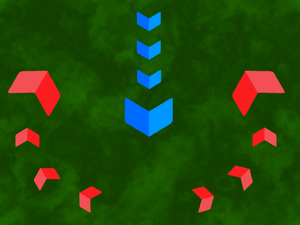Pincer movement facts for kids
The pincer movement is a clever military plan. It's also called a double envelopment. In this tactic, an army attacks both sides, or flanks, of an enemy group at the same time. Imagine a crab's claws closing in – that's how it works!
This move is often used when an enemy army is marching straight towards the middle of your forces. Your army then sends its outer groups to attack the enemy's sides. This helps to surround them. Sometimes, another set of forces might attack even further out. This stops enemy reinforcements (extra troops) from joining the fight.
How it Works
When a pincer movement is fully successful, the attacking army faces the enemy from the front, both sides, and even the back. If the attacking forces meet behind the enemy, the enemy is completely encircled or surrounded.
Battles where an army is surrounded often end with that army giving up or being defeated. The surrounded forces might try to break out (escape) or launch a counterattack (fight back). However, pulling off a successful pincer movement can be very difficult for an army to do.
Famous Examples
Many famous military leaders have used the pincer movement throughout history.
- The ancient Chinese general Sun Tzu wrote about this tactic in his book, The Art of War. He suggested leaving a small escape route for a surrounded enemy. This is because if soldiers have no way out, they will fight much harder. General George S. Patton seemed to follow this advice in 1944. His pincer movement trapped the German army in the Falaise pocket during World War II.
- One of the earliest uses might have been at the Battle of Marathon in 490 BC. The Greek general Miltiades the Younger used it against the Persians. His weaker central forces pretended to retreat. This allowed his forces on the sides to close in behind the Persian battle line. The Persians then ran away in a panic.
- A very famous example happened at the Battle of Cannae in 216 BC. The Carthaginian general Hannibal used the pincer movement against the Romans. Many military experts still see this as one of the greatest battlefield moves ever.
- Charlemagne, a famous king, loved using this tactic. He often split his army into two groups to trap his enemies between them.
- During the American Revolutionary War, Daniel Morgan used it well at the Battle of Cowpens in 1781. British troops thought Morgan's men were running away and charged right into the trap.
- The German blitzkrieg (meaning "lightning war") during World War II often used flanking moves. This involved fast attacks with tanks, artillery (large guns), and aircraft to quickly overwhelm their enemies.
Related pages
- Flanking maneuver
- Turning movement
- Attrition warfare
- Feigned retreat
- Oblique order
- Shock tactics
- Envelopment
- Rearguard
- Ambush
Images for kids
-
Destruction of the Roman army at Cannae
-
Envelopment of the Allied armies in Flanders during the Battle of France
See also
 In Spanish: Movimiento de pinza para niños
In Spanish: Movimiento de pinza para niños




